
Economics_-_New_Ways_of_Thinking
.pdf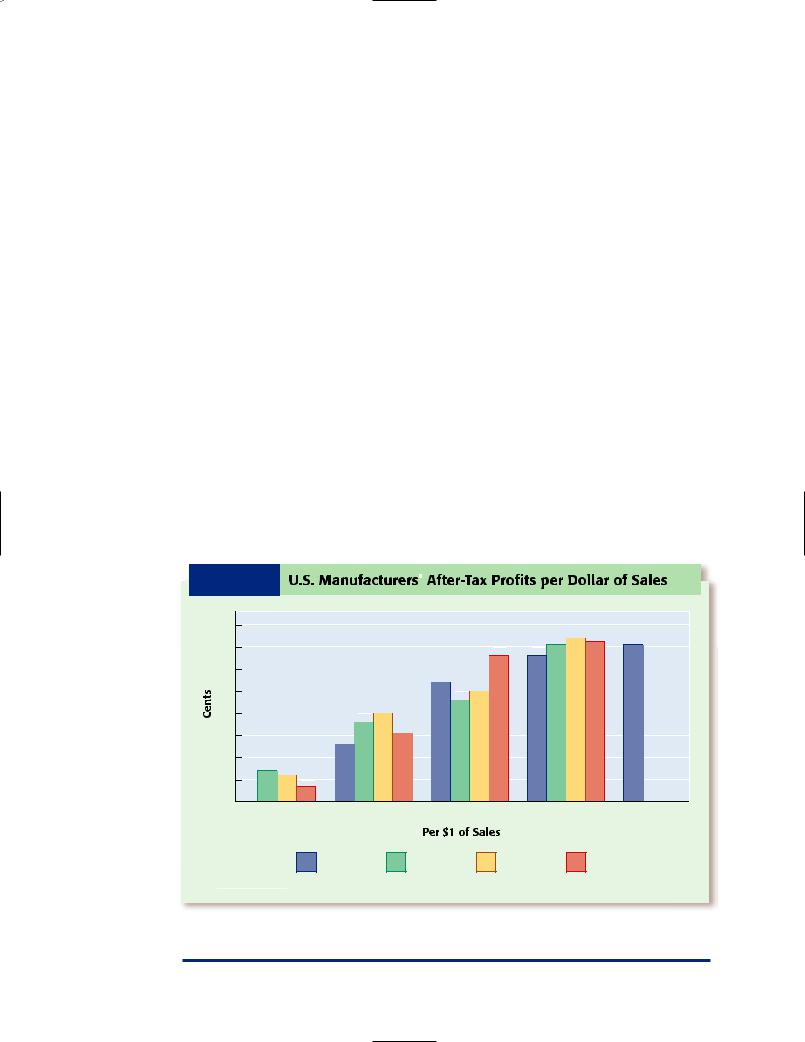
lose only her investment and nothing more. For example, if she bought fifty shares of stock in the corporation at a price of $10 each, her investment is $500. She may never see this $500 again, but she will lose no more.
2.Corporations continue to exist even if one or more owners sell their shares or die. The corporation itself is a legal entity. Its existence does not depend on the existence of its owners.
3.Corporations are usually able to raise large sums of money by selling stock. Because of limited liability, people are more willing to invest in a corporation than in other business forms. The price of a share of stock may be small, so many more people can afford an investment. Furthermore, they can invest as much or as little as they want; for example, a person may buy either 10 or 1,000 shares of stock in a corporation. In addition, because corporations can sell bonds and issue stock, they have ways of raising money that do not exist for proprietorships or partnerships. (We look at bonds and stocks in more detail later in the chapter.)
Disadvantages of Corporations The disadvantages of corporations include the following:
1.Corporations are subject to double taxation. Suppose XYZ Corporation earns $3 million profit this year. This profit is subject to the corporate income tax. If the corporate income tax rate is 25 percent, then $750,000 is paid in taxes, and $2.25 million remains for dividends and other uses. Dividends are shares of the corporation’s profits distributed to stockholders.
Suppose that half of the $2.25 million profit after taxes is distributed to stockholders as dividends. This distribution is considered income for the stockholders and is taxed at personal income tax rates. In short, the $3 million profit was subject to both the corporate income tax and the personal income tax—two taxes, or double taxation. Contrast this situation with the profit earned by a proprietorship, which is subject to only one tax, the personal income tax. Exhibit 7-1 shows after-tax profits per dollar of sales for corporations (that manufacture goods).
E X H I B I T 7-1 U.S. Manufacturers After-Tax Profits per Dollar of Sales
After-Tax Profits per Dollar of Sales
Cents
8 |
|
|
|
|
|
7.1 |
7.4 |
7.2 |
7.1 |
7 |
|
|
|
|
6.6 |
||||
|
|
|
|
6.6 |
|
|
|
||
6 |
|
|
|
6.4 |
|
|
|
|
|
|
|
|
|
5.0 |
|
|
|
|
|
5 |
|
|
|
|
|
|
|
|
|
|
|
4.0 |
|
4.6 |
|
|
|
|
|
4 |
|
|
|
|
|
|
|
|
|
|
|
3.6 |
3.1 |
|
|
|
|
|
|
3 |
|
|
2.6 |
|
|
|
|
|
|
|
|
|
|
|
|
|
|
||
2 |
1.4 |
1.2 |
|
|
|
|
|
|
|
|
0.7 |
|
|
|
|
|
|
||
|
|
|
|
|
|
|
|
|
|
0 |
|
2001 |
2002 |
|
2003 |
2004 |
|
2005 |
|
|
|
|
|
||||||
|
|
|
|
Per $1 of Sales |
|
|
|
|
|
|
|
|
1st qtr |
2nd qtr |
3rd qtr |
|
|
4th qtr |
|
Source: U.S. Census Bureau
What was the change in manufacturers’ after-tax profits from the first quarter of 2002 to the first quarter of 2005?
164 Chapter 7 Business Operations
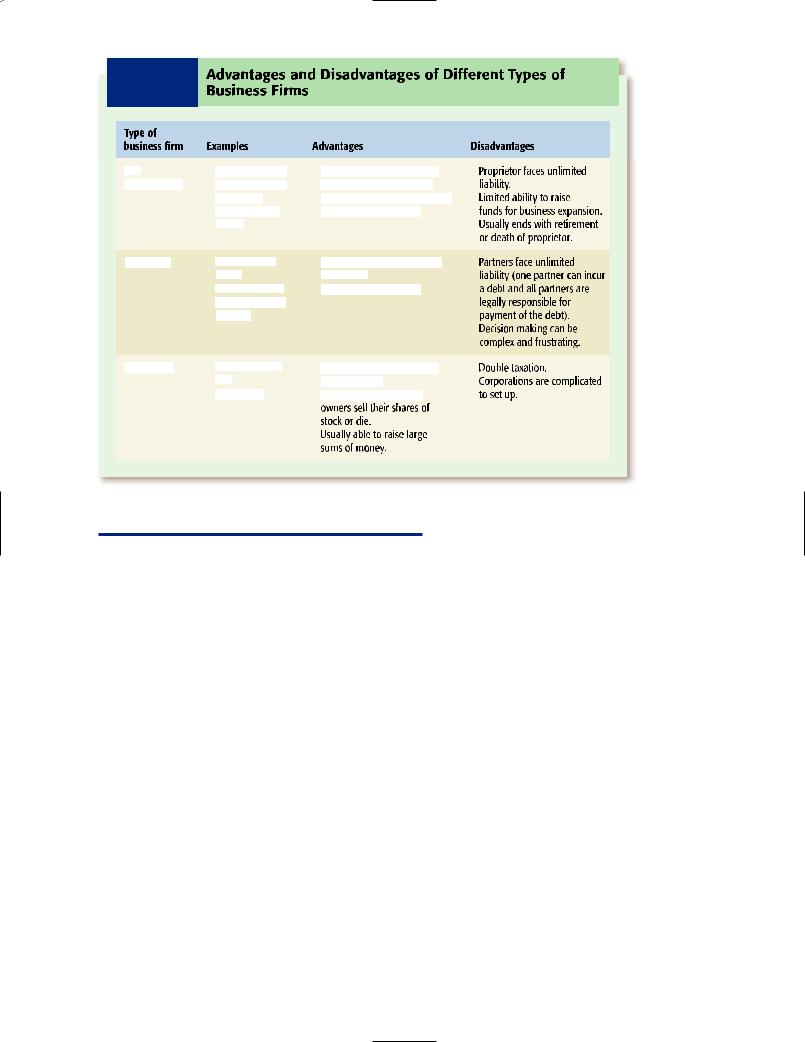
E X H I B I T 7-2 Advantages and Disadvantages of Different Types of Business Firms
Type of |
|
|
|
business firm |
Examples |
Advantages |
Disadvantages |
|
|
|
|
|
• |
|
|
|
|
|
|
|
|
|
|
|
|
|
|
|
|
|
• |
|
|
|
|
|
|
|
|
|
|
|
|
|
|
|
|
|
|
|
Sole |
|
|
|
Local barbershop |
|
Easy to form and to dissolve. |
||||||||||||||||||||||||||||||||||||
|
|
|
|
|
• |
|
|
|
|
|
|
|
|
|
|
|
|
|
|
|
|
• |
|
|
|
|
|
|
|
|
|
|
|
|
|
|
|
|
||||
proprietorship |
All decision-making power |
|||||||||||||||||||||||||||||||||||||||||
|
|
|
Many restaurants |
|
||||||||||||||||||||||||||||||||||||||
• |
|
|||||||||||||||||||||||||||||||||||||||||
|
|
|
|
|
|
|
|
|
|
|
|
|
|
|
|
|
|
|
|
|
|
|
|
|
|
|
|
|
|
|
|
|
|
|
|
|
|
|
||||
|
|
|
|
|
|
|
|
Family farm |
|
|
|
|
|
|
|
resides with the sole proprietor. |
||||||||||||||||||||||||||
|
|
|
|
• |
• |
|||||||||||||||||||||||||||||||||||||
|
|
|
|
|
|
|
|
|
|
|
|
|
|
|
|
|
|
|
|
|
|
|
|
|
|
|
|
|
|
|
|
|
|
|||||||||
|
|
|
|
|
|
|
Carpet-cleaning |
|
|
|
|
Profit is taxed only once. |
||||||||||||||||||||||||||||||
|
|
|
|
|
|
|||||||||||||||||||||||||||||||||||||
|
|
|
|
|
|
|
|
|
|
|
|
|
|
|
|
|
|
|
|
|
|
|
|
|
|
|
|
|
|
|
|
|
|
|
|
|
|
|
||||
|
|
|
|
|
|
|
|
|
service |
|
|
|
|
|
|
|
|
|
|
|
|
|
|
|
|
|
|
|
|
|
|
|
|
|
|
|
|
|
|
|||
|
|
|
• |
|
|
|
|
|
|
|
|
|
• |
|
|
|
|
|
|
|||||||||||||||||||||||
Partnership |
|
|
Some medical |
Benefits of specialization can |
|
|||||||||||||||||||||||||||||||||||||
|
|
|
|
|
|
|
|
|
|
|
|
|
|
|
|
|
|
|
|
|
|
|
||||||||||||||||||||
|
|
|
|
|
• |
|
|
|
offices |
|
|
|
|
|
• |
|
|
|
|
|
be realized. |
|
||||||||||||||||||||
|
|
|
|
|
|
|
|
|
|
|
|
|
|
|
||||||||||||||||||||||||||||
|
|
|
|
|
|
Some law offices |
|
|
Profit is taxed only once. |
|||||||||||||||||||||||||||||||||
|
|
|
|
|
• |
|
|
|
|
|
|
|
|
|
|
|
|
|
|
|
|
|
|
|
|
|
|
|
|
|
|
|
|
|
|
|
|
|
||||
|
|
|
|
|
|
Some advertising |
|
|
|
|
|
|
|
|
|
|
|
|
|
|
|
|
|
|
|
|
|
|||||||||||||||
|
|
|
|
|
|
|
|
|
|
|
|
|
|
|
|
|
|
|
|
|
|
|
|
|
||||||||||||||||||
|
|
|
|
|
|
|
|
|
|
|
|
|
|
|
|
|
|
|
|
|
|
|
|
|
|
|
|
|
|
|
||||||||||||
|
|
|
|
|
|
|
|
|
agencies |
|
|
|
|
|
|
|
|
|
|
|
|
|
|
|
|
|
|
|
|
|
|
|
|
|
|
|
|
|
||||
|
|
|
|
|
• |
|
|
|
|
|
|
|
|
|
|
|
|
|
• |
|
|
|
|
|
|
|
|
|
|
|
|
|||||||||||
Corporation |
|
|||||||||||||||||||||||||||||||||||||||||
|
|
|
|
|
Hewlett-Packard |
|
|
|
||||||||||||||||||||||||||||||||||
|
|
|
|
|
|
|
|
|
|
Owners (stockholders) have |
|
|||||||||||||||||||||||||||||||
|
|
• |
|
|
|
|
|
|
|
|
|
|
|
|
|
|||||||||||||||||||||||||||
|
|
|
|
|
|
|
|
|
|
|
|
|
|
|
|
|
|
|
|
|
|
|
|
|
|
|
|
|
|
|
||||||||||||
|
|
|
|
|
|
|
|
Intel |
|
|
|
|
|
|
|
|
|
|
|
|
|
|
|
limited liability. |
|
|
|
|
|
|||||||||||||
|
|
|
|
|
• |
|
• |
|||||||||||||||||||||||||||||||||||
|
|
|
|
|
|
|
|
|
|
|
|
|
|
|
|
|
|
|
|
|
|
|
|
|
|
|
||||||||||||||||
|
|
|
|
|
|
Walt Disney |
|
|
|
|
|
|
Corporation continues if |
|
|
|
|
|||||||||||||||||||||||||
|
|
|
|
|
||||||||||||||||||||||||||||||||||||||
owners sell their shares of stock or die.
• Usually able to raise large sums of money.
A summary of the advantages and disadvantages of the three types of business firms.
•Proprietor faces unlimited liability.
•Limited ability to raise
funds for business expansion.
•Usually ends with retirement or death of proprietor.
•Partners face unlimited liability (one partner can incur a debt and all partners are legally responsible for payment of the debt).
•Decision making can be complex and frustrating.
•Double taxation.
•Corporations are complicated to set up.
2.Corporations are complicated to set up. Corporations are more difficult to organize than sole proprietorships and partnerships, as we discuss next.
Exhibit 7-2 summarizes the advantages and disadvantages of corporations and compares them with the advantages and disadvantages of proprietorships and partnerships.
The Corporate Structure As a group, the stockholders are the most important persons in a corporation. They are its owners, and they elect the members of the board of directors. Voting for the board of directors is usually an annual event, with each stockholder having the right to cast as many votes as he or she has shares of stock. For example, a person with one share of stock has one vote, whereas a person with 10,000 shares of stock has 10,000 votes.
The board of directors is an important decision-making body in a corporation that
determines corporate policies and goals. It decides what products the corporation will produce and sell, what percentage of the profits of the firm will go to stockholders (as stock dividends), and what percentage will go for modernization and expansion. Also, the board of directors chooses the corporation’s top officers, including the president, one or more vice presidents, the secretary, and the treasurer. These officers carry out the day-to-day operations of the corporation. To do so, they often appoint other vice presidents, as well as department heads, who supervise all other employees in their departments. Exhibit 7-3 on the next page shows this structure.
Financing Corporate Activity All firms, whether proprietorships, partnerships, or corporations, can raise money by borrowing from banks and other lending institutions. Only corporations, however, have two other avenues. They can sell bonds (sometimes
board of directors
An important decisionmaking body in a corporation. It decides corporate policies and goals, among other things.
Section 1 About Business Firms 165
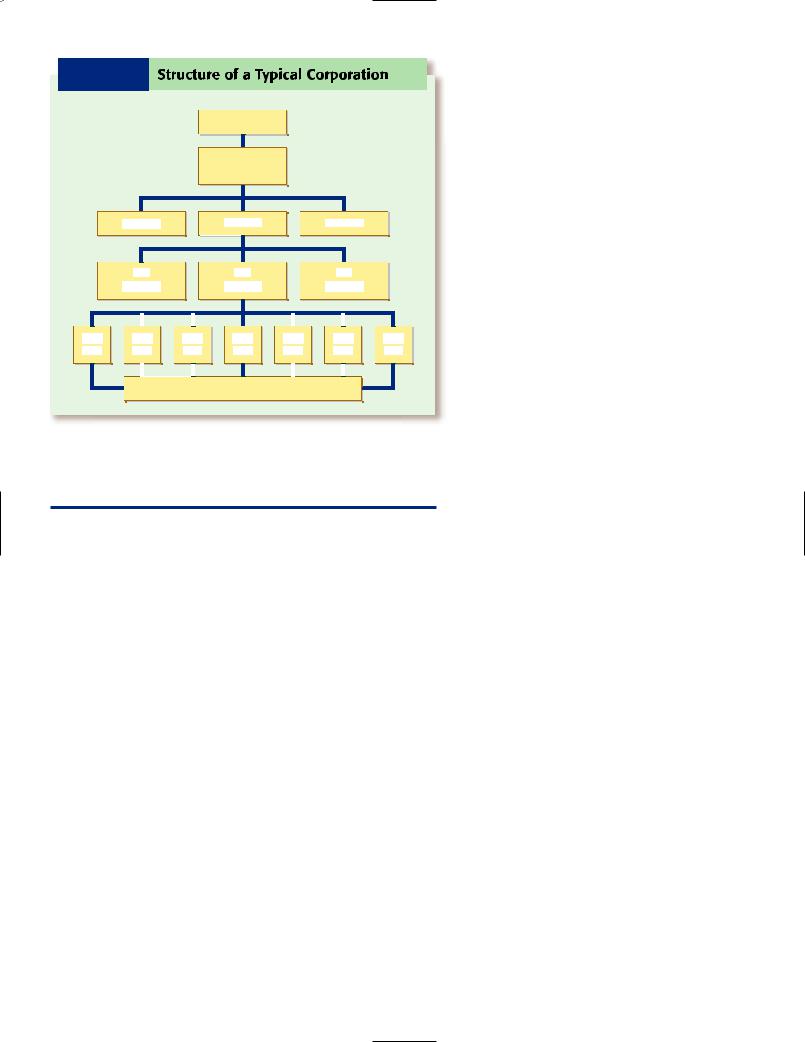
E X H I B I T 7-3 Structure of a Typical Corporation
Stockholders
Board of directors
|
|
|
|
Secretary |
|
|
|
|
|
|
|
President |
|
|
|
|
|
|
|
Treasurer |
|
|
|
|
|
||||||||||||||||||||||||
|
|
|
|
|
|
|
|
|
|
|
|
|
|
|
|
|
|
|
|
|
|
|
|
|
|
|
|
|
|
|
|
|
|
|
|
|
|
|
|
|
|
|
|
|
|
|
|
|
|
|
|
|
|
|
|
|
|
|
|
|
|
|
|
|
|
|
|
|
|
|
|
|
|
|
|
|
|
|
|
|
|
|
|
|
|
|
|
|
|
|
|
|
|
|
|
|
|||
|
|
|
|
|
|
|
|
|
|
|
|
|
|
|
|
|
|
|
|
|
|
|
|
|
|
|
|
|
|
|
|
|
|
|
|
|
|
|
|
|
|
|
|
|
|||||
|
|
|
|
Vice |
|
|
|
|
|
|
|
|
|
Vice |
|
|
|
|
|
|
Vice |
|
|
|
|
||||||||||||||||||||||||
|
|
|
|
|
|
|
|
|
|
|
|
|
|
|
|
|
|
|
|
|
|
|
|
|
|
|
|
|
|
|
|
|
|
|
|
|
|
|
|||||||||||
|
|
|
|
president |
|
|
|
|
|
|
|
president |
|
|
|
|
|
|
president |
|
|
|
|
||||||||||||||||||||||||||
|
|
|
|
|
|
|
|
|
|
|
|
|
|
|
|
|
|
|
|
|
|
|
|
|
|
|
|
|
|
|
|
|
|
|
|
|
|
|
|
|
|
|
|
|
|
|
|
|
|
|
|
|
|
|
|
|
|
|
|
|
|
|
|
|
|
|
|
|
|
|
|
|
|
|
|
|
|
|
|
|
|
|
|
|
|
|
|
|
|
|
|
|
|
|
|
|
|
|
|
|
|
|
|
|
|
|
|
|
|
|
|
|
|
|
|
|
|
|
|
|
|
|
|
|
|
|
|
|
|
|
|
|
|||||||||||||||||
Dept. |
|
Dept. |
Dept. |
Dept. |
Dept. |
|
Dept. |
Dept. |
|||||||||||||||||||||||||||||||||||||||||
|
|
|
|
|
|
|
|
|
|
|
|
|
|
|
|
|
|
|
|
|
|
|
|
|
|
||||||||||||||||||||||||
head |
|
head |
head |
|
head |
head |
|
head |
head |
||||||||||||||||||||||||||||||||||||||||
|
|
|
|
|
|
|
|
|
|
|
|
|
|
|
|
|
|
|
|
|
|
|
|
|
|
|
|
|
|
|
|
|
|
|
|
|
|
|
|
|
|
|
|
|
|
|
|
|
|
|
|
|
|
|
|
|
|
|
|
|
|
|
|
|
|
|
|
|
|
|
|
|
|
|
|
|
|
|
|
|
|
|
|
|
|
|
|
|
|
|
|
|
|
|
|
|
|
|
|
All other employees
Stockholders occupy the top position in a corporation. They elect the board of directors, which in turn chooses the corporation’s top officers (the president and others). Why do you think the stockholders are placed at the top of the corporate structure?
referred to as issuing debt), and they can issue (or sell) additional shares of stock.
Think of a bond as a statement of debt issued by a corporation—an IOU, or piece of paper on which is written a promise to pay. For example, when AT&T issues a bond, it is promising to pay a certain amount of money at a certain time. Here is the process at work:
1.Quentin buys a bond issued by AT&T in the year 2006 for $10,000. The $10,000 is now in the possession of AT&T (the corporation might use the money to help buy new equipment), and the bond (a piece of paper) is in the possession of Quentin.
2.The bond that Quentin has in his hands has a few things written on it. For one thing, it has a dollar figure written on it, called the face value (or par value) of the bond. We’ll say it is $10,000. The percentage written on the bond is called the coupon rate of the bond. The coupon
rate is the percentage of the face value of a bond that is paid out regularly to the bondholders. For Quentin’s bond, we’ll say the coupon rate is 8 percent. Finally, a maturity date written on the bond is the date the bond matures, or is paid off by AT&T. We’ll say this date is 2016.
3.The bond is a legal promise that AT&T makes to Quentin. The promise has two parts. First, AT&T promises to pay the face value of the bond at the maturity date. Second, it promises to pay the coupon rate, times the face value of the bond, each year until the maturity date. The coupon rate is 8 percent, and the face value of the bond is $10,000; 8 percent of $10,000 is $800, so Quentin receives $800 in the year 2006 and in each year through 2016. (This $800 is called the annual coupon payment.) In 2016, Quentin receives not only $800 but also the face value of the bond, $10,000, because 2016 is the maturity date of the bond.
Instead of selling bonds, AT&T could issue stock to raise money. Remember that a share of stock is a claim on the assets of the corporation that gives the purchaser a share of the ownership of the corporation. Whereas the buyer of a corporate bond is lending funds to the corporation, the buyer of a share of stock is acquiring an ownership right in the corporation. So, if you buy a bond from a corporation, you are a lender, not an owner. If you buy shares of stock in a corporation, you are an owner, not a lender.
The key difference between bondholders and stockholders is that the corporation is under no legal obligation to pay stockholders. Bond purchasers have lent money to the corporation, so the corporation must repay these loans, along with extra payments (such as the $800 Quentin received each year), to the bond purchasers for the use of their money. Stockholders do not lend funds to the corporation; instead, they buy a part of it. If the corporation does well, the value of its stock will rise, and they will be able to sell it at a price higher than the price they paid for it. However, if the corporation does not do well, the value of their stock will fall, and they will most likely have to sell it for less than the purchase price.
166 Chapter 7 Business Operations
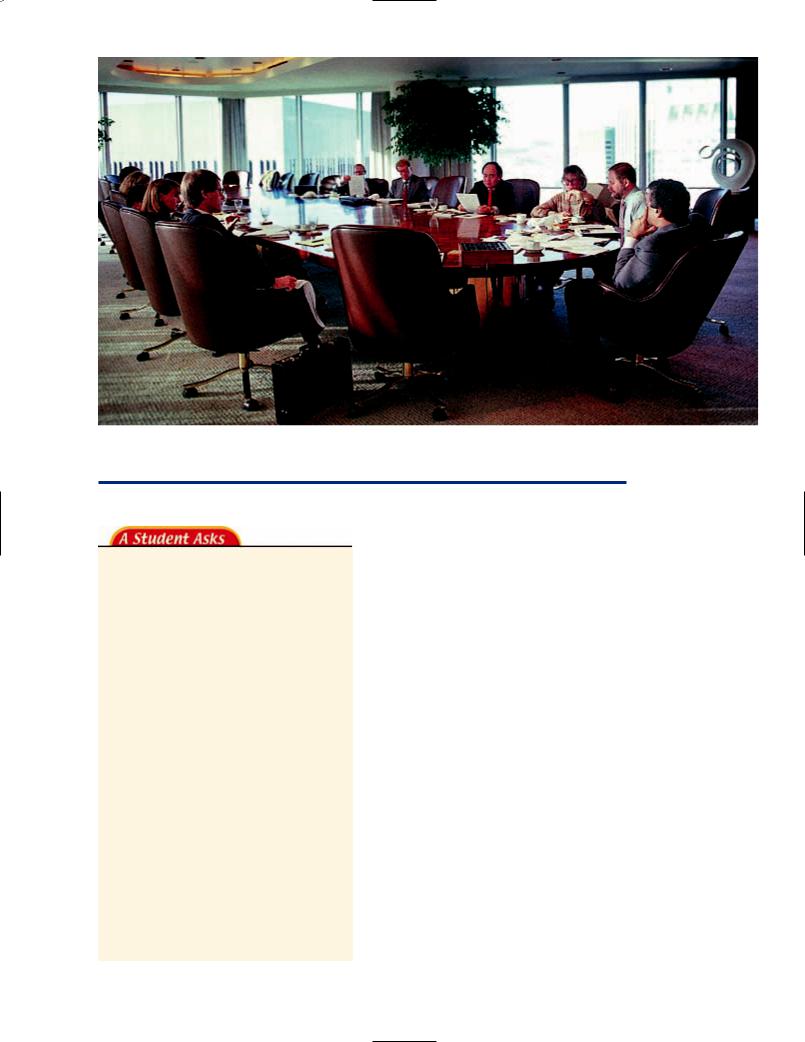
The board of directors are elected to their positions by a vote of the stockholders. What do you think are the major responsibilities of the board of directors?
QUESTION: I’d like to go back to the example of Quentin buying the bond. He buys the bond in 2006 and the bond matures in 2016—10 years later. Suppose Quentin wants to get the money out of the bond before the 10 years have passed. Can he do this?
ANSWER: Yes, he can sell the bond (to anyone willing to buy it) at any time after he purchased it. He does not have to wait for the full 10 years before cashing in the bond. Nothing guarantees, though, that Quentin will sell his bond for the price he paid for it or for more. He might have to sell the bond for less than the purchase price. Why? Because new bonds might have a higher coupon rate than the coupon rate on the (old) bond that Quentin purchased. So he will have to sell his bond for less to compete with the new bonds that are offering a higher coupon rate.
The Franchise
The franchise is a form of business organization that has become more common in the last 25 years. A franchise is a contract by which a firm (usually a corporation) lets a person or group use its name and sell its goods or services. In return, the person or group must make certain payments and meet certain requirements. For example, McDonald’s Corporation offers franchises. Individuals can buy the right to use McDonald’s name and to sell its products, as long as they meet certain requirements. The corporation, or parent company, is called the franchiser; it is the entity that offers the franchise. The person or group that buys the franchise is called the franchisee. A few well-known franchises are McDonald’s, Burger King, Wendy’s, Pizza Hut, Domino’s Pizza, and Taco Bell.
How It Works
The franchise agreement works this way:
(1) The franchisee pays an initial fee. (In
franchise
A contract by which a firm (usually a corporation) lets a person or group use its name and sell its goods in exchange for certain payments and requirements.
franchiser
The entity that offers a franchise.
franchisee
The person or group that buys a franchise.
Section 1 About Business Firms 167
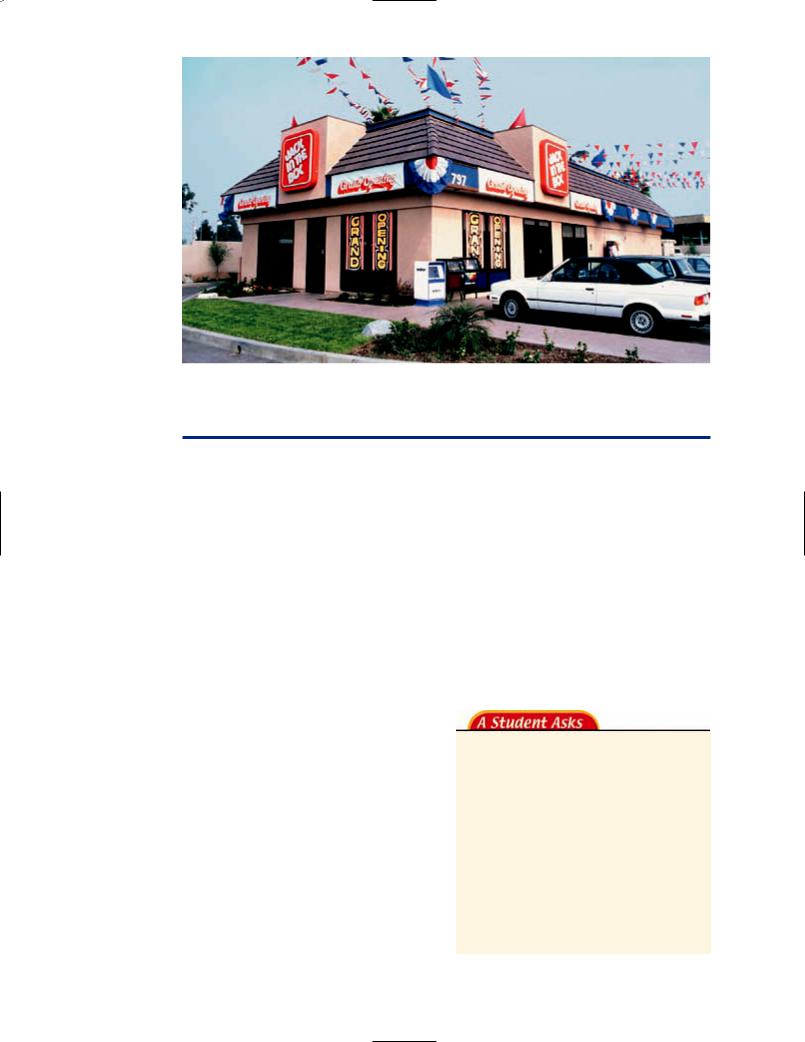
The Jack in the Box franchise led the way in developing and expanding drive-thru dining. If you were going to open a restaurant, why might you consider becoming part of a franchise operation such as Jack in the Box?
2005 the initial fee for a McDonald’s franchise was $45,000.) (2) The franchisee often pays a royalty, or percentage of the profits, to the franchiser for a number of years. At McDonald’s in 2005, the royalty rate was 12.5 percent. (3) The franchisee usually agrees to meet certain quality standards decided on by the franchiser. (For example, all McDonald’s franchises cook Big Macs for the same length of time.) In return, the franchisee receives from the franchiser the right to use the parent company name, the right to sell a certain product, financial assistance, assistance in training employees and personnel, and national advertising.
compared with the risk of opening a McDonald’s or a Burger King. The U.S. Department of Commerce reports that the failure rate is about 12 times higher for independently owned businesses than for franchises.
Of course, franchise business arrangements are not always smooth sailing. Sometimes the franchiser fails to provide the financial and training support the franchisee expects, and occasionally the franchisee does not provide the quality of service and product that the franchiser expects.
Advantages and Disadvantages
Franchises offer several advantages to franchisees. For many franchisees, national advertising is especially important. Consider how many hours of national TV advertising McDonald’s buys annually. This advertising benefits its franchisees from Maine to California. Furthermore, with a wellestablished company such as McDonald’s or Burger King, the franchisee buys a business that has been proved successful. Consider the risk of starting your own restaurant
QUESTION: Is the $45,000 fee the only money one needs to open up a McDonald’s?
ANSWER: No. A person also needs money to buy goods from the suppliers, to pay a certain amount for the building, and so on. A person needs at least $170,000 (that is not borrowed) to open up a McDonald’s. In total a person needs anywhere from $506,000 to $1.6 million to open a McDonald’s.
168 Chapter 7 Business Operations

What Is the Ethical and
Social Responsibility of
Business?
Do businesses have an ethical and social responsibility, and if so, what is it? Here are some different views.
The Nader View
Ralph Nader, the consumer advocate, thinks that businesses do have ethical and social responsibilities. For example, Nader believes that businesses have the responsibility to provide their customers with full information about the products they sell. Ethical companies, says Nader, will often also encourage their customers to “shop around” to make sure they are getting exactly what they want.
According to Nader, businesses should also treat their employees well. For example, businesses should take employee grievances seriously and offer their employees a safe place to work. In addition, when possible, businesses should consider “quality of life” issues (such as employee flex-time, and so on). Nader is also in favor of businesses donating funds to meet social needs in the community.
The Friedman View
According to Milton Friedman, the winner of the 1976 Nobel Prize in economics, “There is one and only one social responsibility of business—to use its resources and engage in activities designed to increase its profits so long as it stays within the rules of the game, which is to say, engages in open and free competition, without deception or fraud.” According to Friedman, if
a company tried to use government to stifle its competition, that company would not be engaging in open and free competition and therefore would be acting unethically. If a company
lied to the buying public about its product, saying the product could provide certain benefits that it actually could not provide, it would be acting unethically.
After a business meets these ethical standards, says Friedman, its job is simple: it should earn as much profit as possible by selling the public something it wants to buy. A business should forget about giving money to the Red Cross, the homeless, or the children’s wing of a hospital. All of these organizations are outside its social responsibility.
Avon Products is one of only 19 companies to make
Business Ethics magazine’s list of 100 Best Corporate Citizens in all six years the award has been given. Avon is known for its threeday fund-raising walks for cancer.
Section 1 About Business Firms 169

Competition for customers often drives similar firms toward each other. The process by which this happens is described on this page and the next.
Asymmetric Information
Asymmetric information exists when one party has information that another party to a transaction does not have. For example, let’s suppose you are planning to buy a used car from Jack. If Jack has some information about the car that he doesn’t pass on to you (the potential buyer), then asymmetric information occurs. The information Jack has but doesn’t pass on to you could affect your decision to buy the car. For example, suppose the car has been in an accident, and you don’t want to buy a car that has been damaged. Without Jack giving you this piece of information, you might end up buying a car you don’t really want to buy.
Asymmetric information can exist in employer-employee situations too. For example, suppose you are being interviewed for a job by a company. The person interviewing you for a job doesn’t tell you that a few employees have gotten sick working at the company because of certain pollutants in the air. Here then is an issue of asymmetric information—the employer has some information about the job that he or she isn’t passing along to you. Suppose also you wouldn’t take this job if you had this information, but without it, you do. The general consensus nowadays is that businesses do have the ethi-
E X H I B I T 7-4 The Location of Firms
(a)
cal responsibility to tell their customers and employees everything relevant to either buying a product or taking a job, respectively.
Where Will Firms Locate?
Economists often want to know what factors firms consider when deciding where to locate. For example, suppose you wanted to go into the farming business—where would you locate? Obviously you might want to locate where farmland is plentiful and the climate is conducive to growing what you want to grow (wheat, corn, etc.). Or suppose you wanted to open up a car dealership. Where would you locate?
At First, Far Apart
To better understand how firms make location decisions, let’s look at a hypothetical situation, as shown in Exhibit 7-4(a). In the exhibit, the letters A through Z represent customers and their locations (say, along a road). You will notice that customers A–Z are evenly distributed along this road. The numbers 1 and 2 represent competing firms, which sell the same goods. They are currently located at extreme ends of the road. If a customer wants to buy a good that either firm 1 or 2 sells, the customer will go to the firm located
2
A |
B |
C |
D |
E |
F |
G |
H |
J |
K |
L |
M |
N |
O P |
Q |
R |
S |
T |
U |
V |
W |
X |
Y |
Z |
|
|
|
|
|
|
|
|
|
|
|
|
|
|
|
|
|
|
|
|
|
|
|
2 |
(b)
A |
B |
C |
D |
E |
F |
G |
H |
J |
K |
L |
M |
N |
O P |
Q |
R |
S |
T |
U |
V |
W |
X |
Y |
Z |
2
(c)
A |
B |
C |
D |
E |
F |
G |
H |
J |
K |
L |
M |
N |
O P |
Q |
R |
S |
T |
U |
V |
W |
X |
Y |
Z |
2
(d)
A |
B |
C |
D |
E |
F |
G |
H |
J |
K |
L |
M |
N |
O |
P |
Q |
R |
S |
T |
U |
V |
W |
X |
Y |
Z |
170 Chapter 7 Business Operations

closer to him or her. This means that customers A–M will buy from firm 1 and customers N–Z will buy from firm 2. If you count the number of customers that each firm sells to, you will find the number is 13.
One Firm Moves, Then the Other
Now suppose that one day firm 1 moves to a different location, as shown in part (b). Ask yourself how this move serves firm 1’s best interest. The answer is that firm 1 takes away customers from firm 2. Now customers A–O are closer to firm 1 than firm 2, so these customers buy from firm 1. Customers Q–Z buy from firm 2 (P isn’t counted; he’s the same distance from 1 and 2.). In short, firm 1’s move put the firm closer to 15 customers instead of 13 customers, leaving 10 customers for firm 2.
Do you think firm 2 will try to counter firm 1’s move? It is likely; after all, the firms are competing for customers. Firm 2 moves to a new location, as shown in part (c). Now customers L–Z go to firm 2, leaving customers A–K to go to firm 1. Firm 1 now has only 11 customers and firm 2 has 15.
A Pattern Develops
notice a pattern. The two firms located on the opposite ends of the road initially, but then the competition for customers moved them closer toward each other. The competition for customers continues. In the end, it is likely that the two firms will be located next to each other, as shown in part (d). At this point, firm 1 will have customers A–M (13 customers) and firm 2 will have customers N–Z (13 customers)—exactly the number of customers each firm started out with in part (a).
What is our conclusion? Simply that similar firms have an incentive to locate near each other. What drives them to this position? The competition for customers.
In the Real World?
Does our theory hold up in the real world? Often, you will notice gas stations located near each other (perhaps, four at an intersection). In many towns, car dealerships are located in the same vicinity, often next to each other. Also, in many towns you will find a certain area of town where many restaurants locate, right next to each other. If you look at major financial firms, you will notice that many of them are headquartered in New York City. In fact, not only are they in the same city, but in
Defining Terms
1.Define:
a.sole proprietorship
b.asset
c.corporation
d.partnership
Reviewing Facts and
Concepts
2.Under what condition will individuals form a firm?
3.The owners of which types of business organizations face unlimited liability?
4.Which type of business organization accounts for the largest share of total business revenue?
5.Why would a company make a boss (monitor) a residual claimant of the firm?
Critical Thinking
6.Do you think the initial fee for all franchises (McDonald’s, Burger King, Play It Again Sports, and so on) is the same? Why or why not?
7.Do you agree or disagree with Milton Friedman’s position on the ethical and social responsibility of business? Explain your answer.
Applying Economic
Concepts
8.If the face value of a bond is $10,000 and the coupon rate is 5 percent, what is the annual payment to the bondholder?
Section 1 About Business Firms 171

Costs
fixed cost
A cost, or expense, that is the same no matter how many units of a good are produced.
variable cost
A cost, or expense, that changes with the number of units of a good produced.
total cost
The sum of fixed costs plus variable costs.
Focus Questions
What are fixed costs?
What are variable costs?
What do total costs equal?
How do we compute fixed cost, variable cost, average total cost, and marginal cost?
Key Terms
fixed cost variable cost total cost average total cost marginal cost
Fixed and Variable Costs
All businesses have costs, but not all costs are the same. For example, suppose Maria Torres owns a business that produces a certain kind of toy. In her business, Torres needs a plant, or factory, in which the toy can be produced. She also needs insurance, employees, machines, certain materials for producing the toy (such as plastic and rubber), paper, pens, computers, electricity, and much more. Consider one of the many things Torres needs—a plant. Currently, she rents a plant from Terry Adams. The rental contract specifies that Torres agrees to pay Adams $2,000 rent each month for 12 months.
What if Torres does not want to rent the plant after she has paid only three months’ rent? Must she pay rent for the remaining nine months? Given the contract that Torres and Adams entered into, the answer is yes. In other words, no matter whether Torres produces 1 toy, 1,000 toys, 10,000 toys, or even zero toys in the plant each month, she still has the legal obligation to pay rent of $2,000 a month for 12 months.
Costs, or expenses, that are the same no matter how many units of a good are produced are called fixed costs. The $2,000 rent is a fixed cost for Torres for a period of 12 months.
 Bobby pays a business tax of $1,000 a year no matter how many paper boxes he produces and sells. The business tax is a fixed cost. Taryn pays $1,500 in insurance for her small store each year, no matter how much she sells. The $1,500 insurance payment is a fixed cost.
Bobby pays a business tax of $1,000 a year no matter how many paper boxes he produces and sells. The business tax is a fixed cost. Taryn pays $1,500 in insurance for her small store each year, no matter how much she sells. The $1,500 insurance payment is a fixed cost.
Now suppose Torres employs 10 workers and pays each $50 a day. Her labor cost per day is $500. One day, she gets a special order for many hundreds of toys. To meet the order, she hires five additional workers at $50 per day. As a result, her weekly labor costs increase by $250, to a total of $750. Notice that the increase in labor cost goes along with an increase in the number of toys being produced. Costs, or expenses, that vary, or change, with the number of units of a good produced are called variable costs.
If we add fixed costs to variable costs, we have total costs:
172 Chapter 7 Business Operations

Total costs Fixed costs Variable costs
Suppose we want to compute total costs for a month. If fixed costs are $2,000 for the month and variable costs are $750, then total costs are $2,750 for the month.
 Jimmy pays $2,000 rent a month on the factory and $1,800 a month for each of the 20 employees he hired. His fixed costs are $2,000 a month, and his variable costs are $36,000 a month. It follows, then, that his total costs are $38,000 a month.
Jimmy pays $2,000 rent a month on the factory and $1,800 a month for each of the 20 employees he hired. His fixed costs are $2,000 a month, and his variable costs are $36,000 a month. It follows, then, that his total costs are $38,000 a month.
Average Total Cost
Suppose a teacher gives a test to five students. The grades are as follows: 80, 90, 100, 60, and 75. The total number of points—the sum of the individual grades—is 405. To find the average grade, we divide the total, 405, by the number of students, 5. The average grade on the test is 81.
Similarly, to compute the average total cost (ATC), or per-unit cost, simply divide total cost (TC) by the quantity of output (Q):
Average total cost (ATC) TCQ
For example, if total cost is $6,000 and 1,000 units of a good are produced, then average total cost is $6 per unit ($6,000/1,000 = $6).
Marginal Cost: An Important
Cost Concept
Marginal cost is an important cost concept in economics. As you will see later, it is one of the two factors a business must know about when deciding how much of a good it is best to produce. For now, though, to illustrate what marginal cost is, suppose Torres currently produces 1,000 units of a toy, and total cost is $6,000. She then decides to produce an additional unit of the toy; in other words, she produces one more toy. As a result, total cost rises from $6,000 to $6,008. What is the change in total cost that results from this change in output?
Well, if total cost was $6,000 and then it rose to $6,008, the change in total cost (from $6,000 to $6,008) must be $8. In other words, total cost has changed by (increased by) $8. This change in total cost that results from producing an additional unit of output is called marginal cost. (Every time you read the word marginal in economics you should think “additional.”) In other words, marginal cost is the additional cost of producing an additional unit of a good. In our example, the marginal cost is $8. When you think about marginal cost, focus on the word change. Marginal cost describes a change in one thing (total cost) caused by a change in something else (quantity of output).
In economics, the triangle symbol (∆) means “change in.” Thus, when we write
Marginal cost (MC) ∆TC
∆Q
we mean “marginal cost equals the change in total cost divided by the change in quantity of output.” We can place the numbers from our example in this equation. ∆TC, the change in total cost, is $8 ($6,008 $6,000 $8). ∆Q, the change in quantity produced, is 1 (1,001 1,000 1):
Marginal cost (MC) $18 $8
The marginal cost is $8. Exhibit 7-5 reviews the five cost concepts discussed in this section.
Do you think these workers at a pineapple cannery most likely represent fixed or variable costs?
average total cost
The total cost divided by the quantity of output.
marginal cost
The cost of producing an additional unit of a good; the change in total cost that results from producing an additional unit of output.
Section 2 Costs 173
